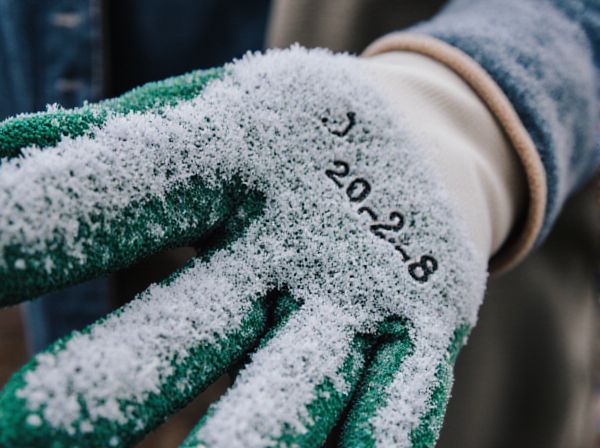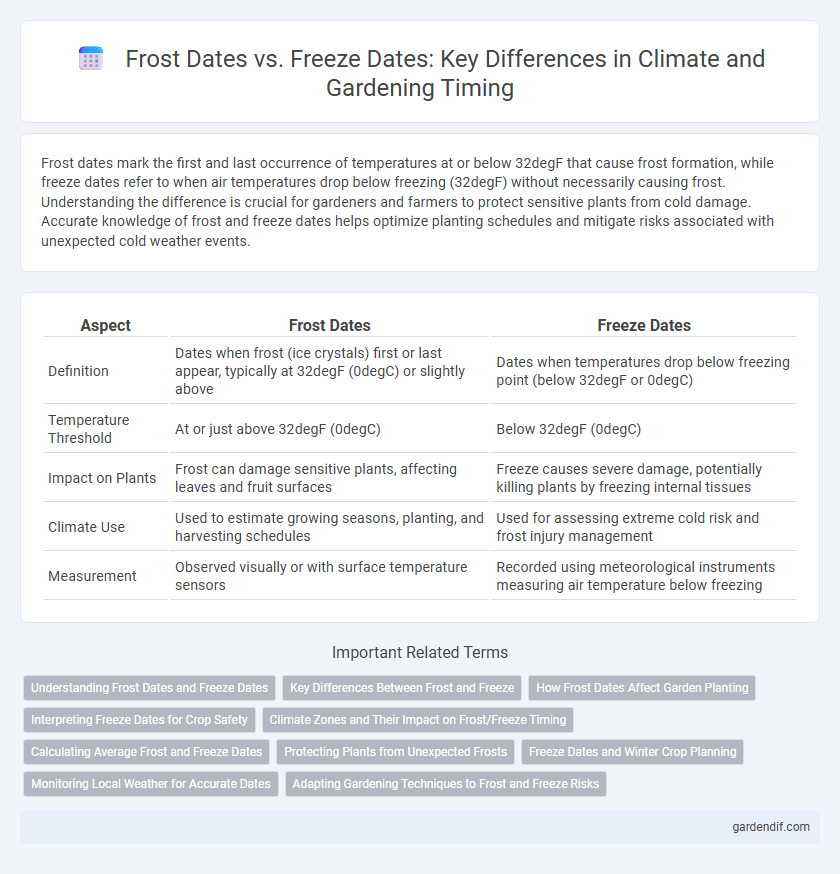
Frost dates vs freeze dates Illustration
Frost dates mark the first and last occurrence of temperatures at or below 32degF that cause frost formation, while freeze dates refer to when air temperatures drop below freezing (32degF) without necessarily causing frost. Understanding the difference is crucial for gardeners and farmers to protect sensitive plants from cold damage. Accurate knowledge of frost and freeze dates helps optimize planting schedules and mitigate risks associated with unexpected cold weather events.
Table of Comparison
| Aspect | Frost Dates | Freeze Dates |
|---|---|---|
| Definition | Dates when frost (ice crystals) first or last appear, typically at 32degF (0degC) or slightly above | Dates when temperatures drop below freezing point (below 32degF or 0degC) |
| Temperature Threshold | At or just above 32degF (0degC) | Below 32degF (0degC) |
| Impact on Plants | Frost can damage sensitive plants, affecting leaves and fruit surfaces | Freeze causes severe damage, potentially killing plants by freezing internal tissues |
| Climate Use | Used to estimate growing seasons, planting, and harvesting schedules | Used for assessing extreme cold risk and frost injury management |
| Measurement | Observed visually or with surface temperature sensors | Recorded using meteorological instruments measuring air temperature below freezing |
Understanding Frost Dates and Freeze Dates
Frost dates refer to the average first and last calendar days when frost is expected, marking surface temperatures falling to 32degF (0degC) or below, affecting tender plants. Freeze dates indicate when air temperatures drop to or below 28degF (-2degC), causing more severe damage to vegetation and crops. Knowing both frost and freeze dates is essential for gardeners and farmers to optimize planting schedules and protect sensitive plants from cold damage.
Key Differences Between Frost and Freeze
Frost dates refer to the expected timeframe when temperatures drop to 32degF (0degC) or lower, causing surface ice crystals to form, while freeze dates indicate when air temperatures fall below 28degF (-2degC), leading to more severe damage by freezing plant cells. Frost primarily affects exposed plant surfaces through the formation of ice on leaves and stems, whereas freeze conditions penetrate deeper, causing cellular damage and increased risk to crops. Understanding the distinction between frost and freeze dates is critical for agricultural planning and protecting sensitive vegetation during cold weather events.
How Frost Dates Affect Garden Planting
Frost dates mark the expected last spring and first fall occurrence of frost, signaling safe periods for planting sensitive garden crops, while freeze dates indicate when temperatures drop below 32degF, risking plant damage. Understanding local frost dates helps gardeners schedule planting to avoid frost injury, optimize growth, and extend the growing season for plants such as tomatoes, peppers, and beans. Accurate tracking of frost and freeze dates supports effective frost protection strategies, including mulching and covering plants during vulnerable periods.
Interpreting Freeze Dates for Crop Safety
Freeze dates indicate the first and last occurrence of temperatures at or below 32degF (0degC), directly impacting crop survival, whereas frost dates may refer to temperatures slightly above freezing that still cause damage. Accurate interpretation of freeze dates allows farmers to schedule planting and harvesting to avoid critical growth stages during freezes, reducing crop loss risk. Monitoring local historical freeze data and using it alongside frost forecasts optimizes crop safety and yield protection.
Climate Zones and Their Impact on Frost/Freeze Timing
Climate zones significantly influence the timing of frost and freeze dates, as colder zones experience earlier and longer periods of freezing temperatures compared to warmer zones. In USDA hardiness zones, frost dates mark the first and last occurrences of temperatures at or near 32degF, while freeze dates indicate more severe temperatures below freezing that can cause damage to plants. Understanding the variation in frost and freeze timing across climate zones is crucial for agricultural planning and protecting crops from cold damage.
Calculating Average Frost and Freeze Dates
Average frost and freeze dates are calculated using historical temperature data collected over 30 years to establish reliable seasonal benchmarks. Frost dates refer to the first and last occurrences of temperatures at or below 32degF (0degC) that cause light damage, while freeze dates denote more severe frost events with temperatures below 28degF (-2.2degC). These calculations inform agricultural planning, helping growers optimize planting and harvesting schedules to minimize crop damage from cold weather.
Protecting Plants from Unexpected Frosts
Frost dates indicate the average first and last occurrences of frost, while freeze dates refer to when temperatures drop below 32degF, causing more severe damage to plants. Gardeners should monitor local frost and freeze dates carefully to implement protective measures such as covering plants or using frost cloths. Understanding these critical temperature thresholds helps prevent crop loss and ensures plant health during early spring and late fall.
Freeze Dates and Winter Crop Planning
Freeze dates mark the onset or end of temperatures falling below 32degF, crucial for timing winter crop planting to avoid frost damage. Understanding the last spring freeze and first fall freeze helps farmers select suitable crop varieties and schedule sowing to maximize yield. Accurate freeze date data reduces the risk of crop loss by informing protective measures like row covers or adjusting planting windows.
Monitoring Local Weather for Accurate Dates
Tracking frost dates and freeze dates requires precise local weather monitoring to ensure agricultural and gardening activities align with actual climatic conditions. Utilizing data from regional weather stations and historical climate records helps predict first and last frost occurrences with higher accuracy. Real-time temperature tracking through smart sensors also enhances the ability to prepare for sudden temperature drops, minimizing crop damage.
Adapting Gardening Techniques to Frost and Freeze Risks
Frost dates indicate when surface temperatures dip below 32degF, causing frost formation, while freeze dates mark prolonged air temperatures below freezing, threatening plant survival. Gardeners adapt by selecting frost-resistant crops, using row covers, and timing planting schedules around regional frost and freeze data from sources like the USDA Plant Hardiness Zone Map. Applying techniques such as mulching and frost forecasting apps helps minimize damage and extend growing seasons in variable climate conditions.
Frost dates vs freeze dates Infographic

 gardendif.com
gardendif.com